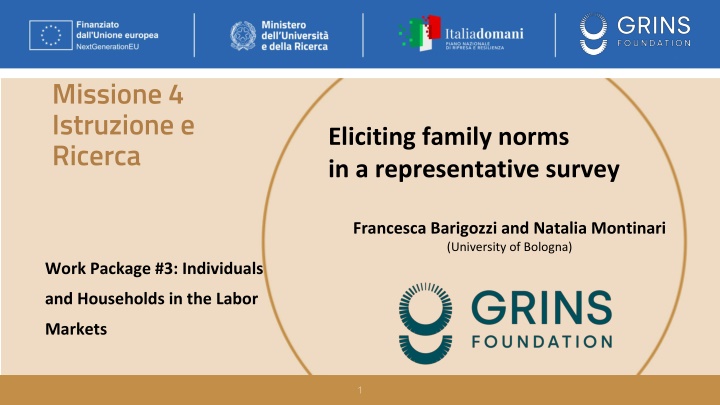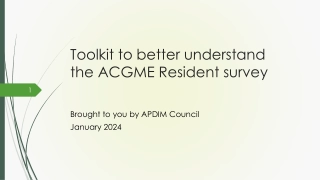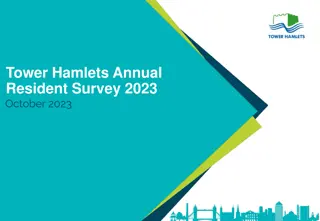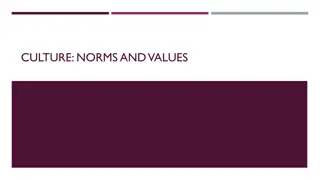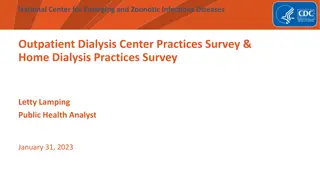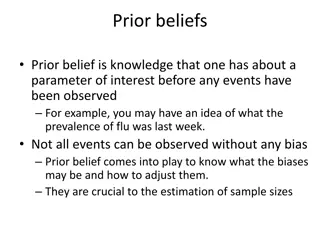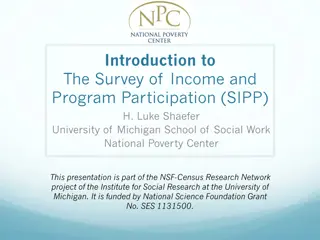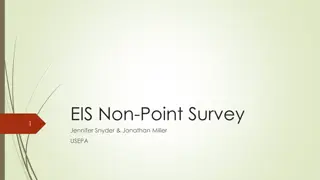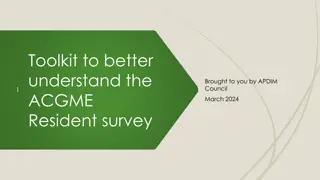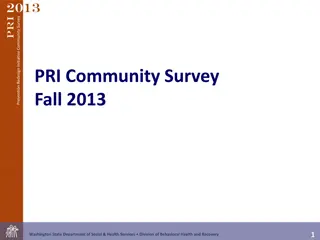Eliciting Family Norms in a Representative Survey
A representative survey conducted in Italy focused on eliciting family norms through social norm elicitation techniques. The survey comprises three parts including demographic information, household composition, incentivized social norm elicitation on vignettes, personal views on gender norms, and psychological traits. Participants provided responses on various statements and scenarios related to family dynamics and gender roles.
Download Presentation

Please find below an Image/Link to download the presentation.
The content on the website is provided AS IS for your information and personal use only. It may not be sold, licensed, or shared on other websites without obtaining consent from the author.If you encounter any issues during the download, it is possible that the publisher has removed the file from their server.
You are allowed to download the files provided on this website for personal or commercial use, subject to the condition that they are used lawfully. All files are the property of their respective owners.
The content on the website is provided AS IS for your information and personal use only. It may not be sold, licensed, or shared on other websites without obtaining consent from the author.
E N D
Presentation Transcript
Missione 4 Istruzione e Ricerca Eliciting family norms in a representative survey Francesca Barigozzi and Natalia Montinari (University of Bologna) Work Package #3: Individuals and Households in the Labor Markets
A representative survey Representative survey (N=1501) of the Italian population, data collected in June 2020, funded with personal research funds. Representativeness as for 1) four ISTAT macro areas (Nord-west, Nord-east, Center, South and Islands) 2) Gender 3) three age groups: 25-34; 35-49; 50-64. Six-month (March-August 2023) pre-doc financed by GRINS (Caterina Gaggini)
The sample N=1501, Data collection: June 2020, CAWI. Average length: 23.4 min. (St.Dev. 10.5 min)
Surveys structure The survey is composed of three parts: 1. Demographic Info and Household composition 2. Incentivized Social Norm Elicitation (Krupka & Weber, 2013) on 4 vignettes + 1 question with 5 claims (4 from WVS +1 we phrased) 3. Info about own and household members jobs, allocation of chores within the household, Personal views about the same questions presented in part 2, and psychological traits (TIPI, self-reported risk attitude). Many questions are similar to those in the socioeconomic survey associated with the observatory on Time Use (specifically on gender norms).
Example: a claim from the World Value Survey Wave 7, 2017-2020 52.7% of Italians agree and strongly agree with the statement Preschool child suffers with working mother. Elicitation via personal attitudes- Unincentivized INSTRUCTIONS: Indicate what you think of the following statement: A preschool child is likely to suffer if his or her mother works full-time Elicitation via Krupka Weber (2013)- Incentivized INSTRUCTIONS: For this statement, we ask you to guess the answer chosen by most people similar to you (i.e., of the same gender, age, and living in the same geographical area). You will earn 3 euros for each correct answer. The social element of norms requires that group members recognize or hold them jointly or mutually (Ostrom, 2000).
Example: Vignette 1 Antonio and Francesca are married or cohabiting. They both work the same number of hours, earn roughly the same amount of money, and have the same career trajectories. They have no children and no one to help them with the housework. Scale of Judgement Very socially inappropriate Somewhat socially inappropriate Somewhat socially appropriate Very socially appropriate Two different framings about who takes the initiative (varied between subjects) Francesca is willing to take care of up to of the housework and leaves of them to Antonio. Antonio is willing to take care of up to of the housework and leaves of them to Francesca. Francesca is willing to share household chores equally with Antonio. Antonio is willing to share household chores equally with Francesca. Francesca is willing to take care of up to of the housework and leaves of them to Antonio. Antonio is willing to take care of up to of the housework and leaves of them to Francesca.
Monetary incentives Scenari SRL uses a point-based system for respondents; points are assigned based on the length of the survey (min 1 max 12), and 50 points are worth a 10 Euro Amazon Gift Card. For our survey, they assigned 20 points. At the end of the data collection, we randomly selected 150 participants and 1 of the questions presented in part 2 (4 vignettes + 1 question with 5 claims). Payments via Amazon Gift Card: 3 Euros per correct answer in the selected scenario/question (3/5 statement included). Total incentive cost: 747 Euro (average prize 5 Euro). Vignette B was randomly selected 39% of participants provided two correct answers out of 3.
Three ongoing projects From personal values to social norms : 5 claims (4 WVS + 1 claim we phrased) Eliciting family norms in a representative survey : 4 VIGNETTES Gender roles and Mental load : using the questions Who takes care of family management and household organization? and How are chores within the household shared? (still ongoing) Overall link with work package #3: gender norms affect the inequality in the household that, in turn, affects the gender inequality in the labor market.
First project: From personal values to social norms We compare the two ways of measuring social norms used in the Economic literature : via personal values (first-order beliefs). via incentivized expectations of others personal values (second-order beliefs). RESEARCH QUESTIONS: Are the two methods generating systematic differences in social norms elicitation? If yes, why? Is this difference related to personal agreement/disagreement with perceived social norms? Or is it related to whether social norms are correctly perceived or misperceived? RESULTS: Social norms elicited via first-order beliefs (WVS) are systematically more progressive than norms elicited via second-order beliefs. Most respondents report Personal Values as more progressive than the perceived norm. Such behavior is consistent with a desirability or self-image bias (disagreement with perceived norms).
Second project: Eliciting family norms in a representative survey We elicit the social norm regulating how family and household duties should be shared between partners. RESEARCH QUESTIONS traditional male-breadwinner model or equality between partners model ? Are men and women treated equally when deviating from equality? Are women still perceived as the main caregivers in society? RESULTS We document the evolution of the norms by comparing generations Decline of the breadwinner model Double standard (persisting in the young generation) Framing effects exacerbate the double standard
